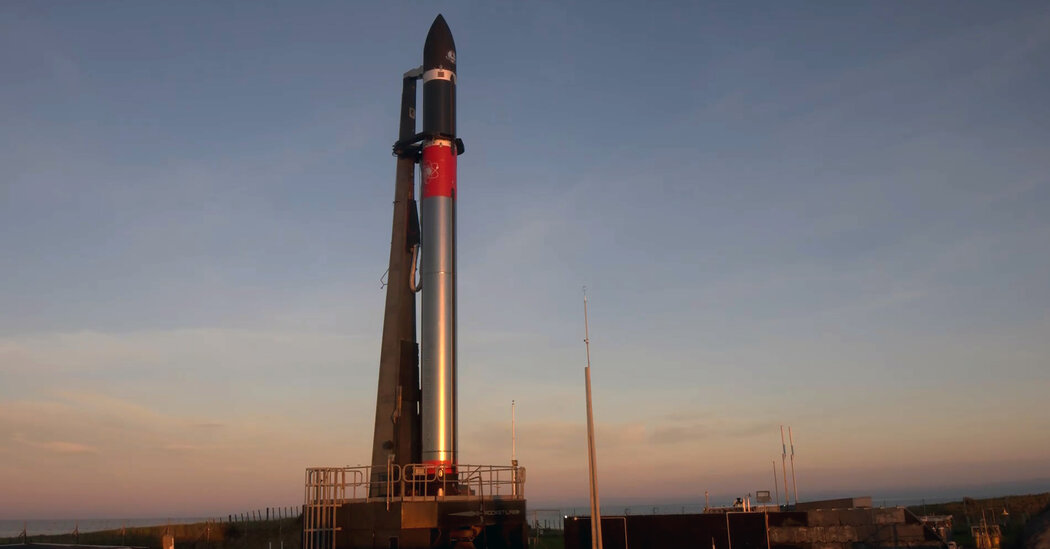
Catch a falling rocket and bring it back to shore …
On Tuesday (Monday evening in New York), Rocket Lab, a small company with a small rocket, pulled off the first half of that feat during its latest launch from the east coast of New Zealand.
After sending a payload of 34 small satellites to orbit, the company used a helicopter to catch the 39-foot-long used-up booster stage of the rocket before it splashed into the Pacific Ocean.
In the future, Rocket Lab hopes to refurbish a recovered booster and then use it for another orbital mission, an achievement that so far has been pulled off by only one company: Elon Musk’s SpaceX.
A video stream from the helicopter showed a long cable dangling from the aircraft with cloudy skies below. Then the booster came into view dangling under the parachute.
“There we go, we’ve got our first glimpse of it,” said Murielle Baker, the commentator during the Rocket Lab broadcast. The grappling hook at the end of the helicopter’s cable snagged the parachute line before the captured booster swung and exited the camera view.
Cheers from Rocket Lab’s mission control at first confirmed a successful catch.
However, the company later provided an update that qualified the success. Peter Beck, the chief executive of Rocket Lab, said on Twitter that the helicopter pilots reported that the booster was not hanging below the helicopter quite in the same way as during test runs and that they let it go to splash down in the ocean, where it was recovered by a Rocket Lab ship.
Eventually, Rocket Lab would like the helicopter to carry a caught booster all the way back to land and prevent damage from salt water that makes reuse of a booster challenging and possibly impractical.
Rocket Lab gives most of its missions whimsical names. This one was called “There and Back Again,” a nod to the recovery of the booster as well as the subtitle of J.R.R. Tolkien’s “The Hobbit” novel. The trilogy of Hobbit movies by director Peter Jackson was shot in New Zealand.
Rocket Lab’s booster catch is the latest advance in an industry where rockets used to be expensive single-use throwaways. Reusing all or part of one helps lower the cost of delivering payloads to space and could speed the pace of launching by reducing the number of rockets that need to be manufactured.
“Eighty percent of the cost of the whole rocket is in that first stage, both in terms of materials and labor,” Peter Beck, the chief executive of Rocket Lab, said in an interview on Friday.
SpaceX pioneered a new age in reusable rockets and now regularly lands the first stages of its Falcon 9 rockets and flies them over and over. The second stages of the Falcon 9 (as well as Rocket Lab’s Electron rocket) are still discarded, typically burning up while re-entering Earth’s atmosphere. SpaceX is designing its next-generation super rocket, Starship, to be entirely reusable. Competitors like Blue Origin and United Launch Alliance, and companies in China, are similarly developing rockets that would be at least partially reusable.
NASA’s space shuttles were also partially reusable, but required extensive and expensive work after each flight, and they never lived up to their promise of airliner-like operations.
For the Falcon 9, the booster fires several times after it separates from the second stages, slowing it en route to a setting down softly on either a floating platform in the ocean or a site on land. The Electron is a much smaller rocket, which makes reuse more challenging.
“You have to spend every bit of your propellant just to get missions up,” Mr. Beck said. That ruled out the possibility of propulsive landings like the Falcon 9 boosters.
Instead, Rocket Lab engineers figured out a more fuel-efficient approach, adding a system of thrusters that expels cold gas to orient the booster as it falls, and thermal protection to shield it from temperatures exceeding 4,300 degrees Fahrenheit.
The booster separated from the second stage at an altitude of about 50 miles, and during the descent, it accelerated to 5,200 miles per hour.
“If we came in flat, for example, on the side, the rocket would just burn up,” Mr. Beck said. “So we have to orientate and control that first stage to have the heat shield and engines down during the entire flight profile.”
The friction of the atmosphere acted as a brake. Around 7 minutes, 40 seconds after liftoff, the speed of the booster’s fall slowed to under twice the speed of sound. At that point, a small parachute called the drogue deployed, adding additional drag. A larger main parachute further slowed the booster to a more leisurely rate.
Rocket Lab had demonstrated on three earlier launches that Electron boosters can survive re-entry. But on those missions, the boosters splashed in the ocean and were then pulled out for examination.
This time, a Sikorsky S-92 helicopter hovering in the area met the booster midair, dragging a cable with a grappling hook across the line between the drogue and main parachutes.
With almost all of its propellant expended, the booster was much lighter than at launch. But it was still a weighty piece of metal — a cylinder four feet in diameter and about as tall as a four-story building and weighing nearly 2,200 pounds or a metric ton.
Mr. Beck said eventually Rocket Lab would like to catch boosters for about half of its missions. The added weight of the thrusters, parachutes and thermal protection reduces the payload of 550 pounds by 10 to 15 percent.
Later this month, Rocket Lab could launch CAPSTONE, a NASA-financed but privately operated mission, that will study a highly elliptical path around the moon to be used by a future American lunar space station. Before the end of this year, Rocket Lab hopes to start using a second launch site on Wallops Island in Virginia.




